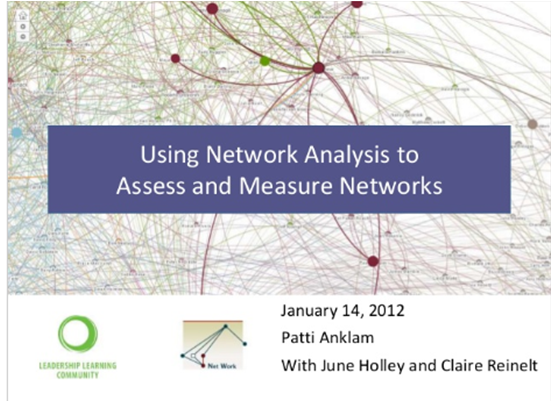Patti Anklam, an affiliate of New Directions Collaborative and Principal of Net Work, offered a Leadership Webinar, hosted by the Leadership Learning Community (LLC,) about techniques for social network analysis. In this Guest Blog post, Patti shares an overview of the webinar, with links to listen to it and further resources.
Monday’s LLC webinar on Network Analysis Methods (SNA/ONA) for Assessment and Measurement networks gave me an opportunity to put my thoughts and some structure around the work I’ve been doing over the past two years working with nonprofits. The surge in interest in network thinking and using networks to drive better results among nonprofits has generated interest in the topic of just how network analysis can be used effectively:
- Before network building, to assess the collaborative capacity of a set of stakeholders who might be interested
 in formalizing a network structure
in formalizing a network structure - To measure the extent to which network-building activities have created information-sharing or collaborative relationships, and if possible to measure them over time in a way to show changes
- For making sense of, and validating, the role of network-building in creating unanticipated outcomes
- To understand how individuals’ experience of being in a network alters their personal relationships and leads them to become better performers
With assistance from Claire Reinelt and June Holley, I was able to provide case studies of using network analysis in each of the above scenarios. This isn’t an exhaustive list of the ways that network analysis is being used, but to keep to the time limit in the webinar, we settled on these three. I hope people will listen to the replay of the webinar to hear these case studies and also to get a sense of how to put them in context.
The art of getting useful results in an analysis — by which I mean, and often belabor — is that you get maps and metrics that lead to really really good questions. In the context of weaving networks, some of the questions we like to ask are:
- Have you collaborated with this person?
- Do you actively and frequently share information and resources with this person?
- Has this person inspired you?
- Have you learned something from this person who has helped you become a better leader?
- Could you be more effective if you could collaborate with this person?
Analysis results yield both maps and metrics. The quantitative data includes:
- Overall network cohesiveness (how many people are connected out of a total of 100%?)
- The average “degrees of separation”
- The average number of connections each individual has
- The number of people who connect to/from each person
- The diversity of an individual’s network (how many connections do they have to people outside of their own geography or expertise area?)
It is in finding the right questions and the right demographics that a network analysis will result in interesting results. “Interesting” means that (yes, I’ll say it again), it helps you ask good questions:
- What was the impact on this person of convening the network annually?
- Why are the people in this geography so little connected to the other regions?
- What happens if the foundation staff — who are so central to this network — are no longer available to broker connections and introductions?
That’s when an analysis is successful, and why it’s important that a network analysis with all its colorful maps and mind-boggling metrics needs to be accompanied by serious and thoughtful gathering of qualitative information. The best use of network analysis in nonprofit assessment and measurement is when it is accompanied by stories. The maps do two things:
- They provide indicators for where there might be something interesting to probe into
- They provide interesting visual results to support stories about outcomes
There is still a lot to learn about using network analysis in nonprofit assessment and measurement. For example, while it is interesting to show increases in connectivity (the SNA “density” metric) over time, we have to wonder what the threshold for density is. How connected is “enough?” And once it is enough, do we shift our weaving tactics toward network maintenance and what does that look like?
It will take a concerted, collaborative effort by practitioners to create and share a database that helps identify appropriate questions, salient comparative metrics for networks of different sizes and purposes, and a compendium of useful interventions.
The goal is simply to get better at building effective networks where it makes sense to do so.
